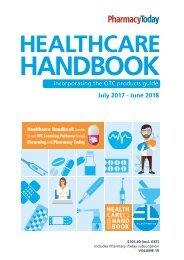2017 HCHB_digital
You also want an ePaper? Increase the reach of your titles
YUMPU automatically turns print PDFs into web optimized ePapers that Google loves.
CONTINUING OTC EDUCATION<br />
Sun Protection Advice<br />
Slip, Slop, Slap and Wrap!<br />
••<br />
Slip on a shirt and slip into the shade in summer<br />
»»<br />
Put on standard-approved sun-protective clothing or wear dark, tightly woven clothes.<br />
Seek shade between 10am and 4pm.<br />
••<br />
Slop on sunscreen<br />
»»<br />
Use an SPF 50+ broad spectrum sunscreen (that meets the revised AUS/NZS 2604:2012)<br />
»»<br />
Apply thickly (use at least seven teaspoonsful or 35ml) 15–20 minutes before going<br />
outside<br />
»»<br />
Reapply every two hours as well as after swimming or sweating.<br />
••<br />
Slap on a hat<br />
»»<br />
Choose a hat with a wide brim or a cap with flaps.<br />
••<br />
Wrap on a pair of sunglasses.<br />
»»<br />
Choose standard-approved wrap-around sunglasses.<br />
Sunscreen should not be used as a way of staying out in the sun longer, but as a way of reducing<br />
risk of UV exposure.<br />
ingredients (eg, oxybenzone, octyl methoxy cinnamate, octocrylene) and physical<br />
sunscreens, such as zinc and titanium oxide.<br />
Sensible sun protection is unlikely to make people vitamin D deficient as vitamin<br />
D is still made by the skin in the shade with sunscreen on. Sunscreens that allow for<br />
vitamin D production allow one specific wavelength of UVB light to penetrate the skin<br />
in order to make vitamin D. Therefore the benefits of allowing vitamin D penetration<br />
need to be weighed against the risks of unlimited penetration of that UVB wavelength<br />
all day. Sunsmart NZ and the NZ Ministry of Health recommend 30 minutes of sun<br />
exposure without sunblock every day before 10am and after 4pm from September<br />
to April. From May to August, 30 minutes of sunblock-free sun exposure should take<br />
place around the middle of the day.<br />
Initial assessment<br />
Despite New Zealand having higher levels of UV radiation than most of the rest of the<br />
world, we are not generally very good at applying sunscreen. For customers buying<br />
sunscreen, take note of their skin type and stress the importance of never getting<br />
sunburnt, especially to those with fair skin. Explain the different types of sunscreen<br />
and encourage proper and regular application (see text box Sun Protection Advice<br />
above). Educate visitors from overseas about the dangers of our sun and that<br />
protection is often required for most of the day (ie, 9.30am – 5pm) during summer.<br />
Sell customers presenting with mild sunburn a topical cooling preparation (eg,<br />
aloe vera) and an SPF 50+ sunscreen for future use. Refer anybody with "yes"<br />
answers to the Refer to Pharmacist questions to a pharmacist.<br />
Refer to<br />
PHARMACIST<br />
The following questions aim to identify customers who would benefit<br />
from further input from a pharmacist. Your initial assessment may<br />
have already provided some answers. Decide if any further questions<br />
still need to be asked and refer any “yes” answers to a pharmacist.<br />
• Does the person have any other health conditions (eg,<br />
immunosuppression, cancer)?<br />
• Does the person take any other medication, either prescribed by a<br />
doctor or bought from a shop or supermarket (including herbal/<br />
complementary medications) that may affect how long they should<br />
stay in the sun?<br />
• Does the person have severe sunburn and blisters?<br />
• Is the person in extreme pain, feeling unwell or have a headache?<br />
• Is the person complaining of burning more easily than before,<br />
especially if sun exposure has been minimal?<br />
• Is the person a young child with moderate to severe sunburn?<br />
• Does the person have any other symptoms, apart from sunburn?<br />
• Does the sunburn appear to be a recurring problem?<br />
• Does the person have any suspicious-looking moles?<br />
• Is the person allergic to any topical ingredients?<br />
»»<br />
ALL sunscreens need to be reapplied after immersion in water or after<br />
sweating.<br />
• Warn people taking phototoxic medications (eg, doxycycline) to limit sun<br />
exposure and use a broad-spectrum sunscreen when outside.<br />
• Avoid sunbeds since the risk of skin cancer is increased. Artificial tanning lotions<br />
may be used to create a tanned look without exposure to the sun.<br />
• Store sunscreen away from heat and discard once expired.<br />
Advice for customers<br />
• Sunscreen is considered safe to use on full-term babies over six months of<br />
age; however, it is still best to keep them out of the sun as much as possible.<br />
• Water-resistant sunscreen products retain sun protection properties for at<br />
least 40 minutes in water.<br />
SunSense is a premium sunscreen range,<br />
scientifically formulated for individual<br />
skin types. SunSense provides very high<br />
UVA and UVB broad spectrum protection.<br />
SunSense is fragrance free,<br />
non-comedogenic and contains added<br />
moisturisers to hydrate skin<br />
Always read the label,<br />
use only as directed<br />
NZ’s #1 Sunscreen brand in Pharmacy *<br />
*Iri Market Data, NZ National Pharmacy 13 wks to 22/01/17<br />
Page 145



